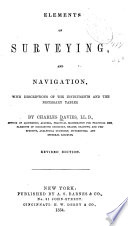 | Charles Davies - Navigation - 1854 - 446 pages
...Multiplying equations (1) and (2), member by member, we have, Wm + n = MxN OT,m + n=log(MxN); hence, The sum of the logarithms of any two numbers is equal to the logarithm of their product. 4. Dividing equation (1) by equation (2), member by member, we have, 10m~n = -^or, m... | |
 | Adrien Marie Legendre, Charles Davies - Geometry - 1857 - 442 pages
...have, I0m = Jf (1) 10" = ^ (2). Multiplying equations (1) and (2), member by member, we have, hence, The sum of the logarithms of any two numbers is equal to the logarithm of their product. 4. Dividing equation (1) by equation (2), member by member, we have, , , Jf J/ 10m~"... | |
 | Charles Davies - Algebra - 1860 - 330 pages
...logarithms of any two numbers equal? To what, then, will the 'addition of logarithms correspond? * The sum of the logarithms of any two numbers is equal to the logarithm of their product. Therefore, the addition of logarithms corresponds to the multiplication of their numbers.... | |
 | Charles Davies - Algebra - 1861 - 322 pages
...the exponent bj m, what will represent the corresponding number ? What is the logarithm of a number i The sum of the logarithms of any two numbers is equal to >ke logarithm of their product. Therefore, the addition of logarithms corresponds to the multiplication... | |
 | Charles Davies - Algebra - 1864 - 316 pages
...what will represent the corresponding number ? What ¡3 the logarithm of я number ? УЛе виетг of the logarithms of any two numbers is equal to the logarithm of their product. Therefore, the addition of logarithms corresponds to the multiplication of tlieir numbers,... | |
 | Charles Davies - Algebra - 1867 - 316 pages
...logarithms of any two numbers equalf To what, then, will the addition < f logarithms correspond ? 2'he sum of the logarithms of any two numbers is equal to the logarithm of th-eir product. Therefore, the addition of logarithms corresponds to the multiplication of their numbers.... | |
 | Charles Davies - Algebra - 1867 - 322 pages
...the exponent by m, what will represent the corresponding number ? What is the logarithm of a number 1 The sum of the logarithms of any two numbers is equal to 'he logarithm of their product. Therefore, the addition of logarithms corresponds to the multiplication... | |
 | C. Davies - 1867 - 342 pages
...Multiplying equations (1) and (2), member by member, we have 10m*° = MxN or, m+n — log MxN : hence, The sum of the logarithms of any two numbers is equal to tJ1e logarithm of their productDividing equation (1) by equation (2), member by member, we have ™-.... | |
 | Charles Davies - Geometry - 1870 - 392 pages
...Multiplying equations (1) and (2), member by member, we bave lo"*" = MxN or, m+n = log MxN: hence, The sum of the logarithms of any two numbers is equal to the logarithm of their product. Dividing equation (1) by equation (2), member by member, we have n »-. M ,.-*•, 10... | |
 | Charles Davies - Algebra - 1891 - 312 pages
...10" = lO""1"1 = MxN. But, since 10 is the base of the system, m -f- n is the logarithm of MX N. Hence The sum of the logarithms of any two numbers is equal to the logarithm of their product. Therefore the addition of logarithms corresponds to the multiplication of their numbers.... | |
| |